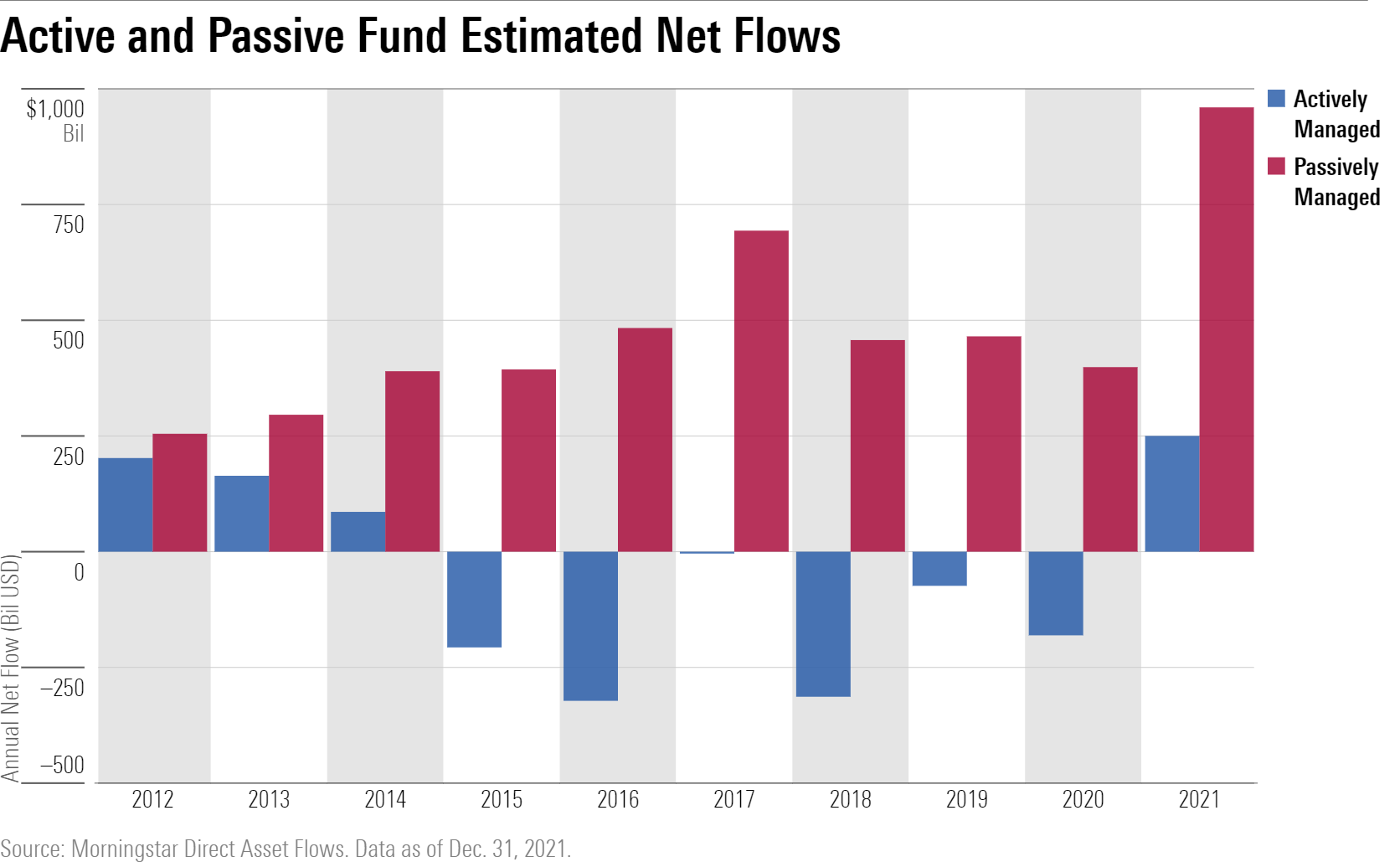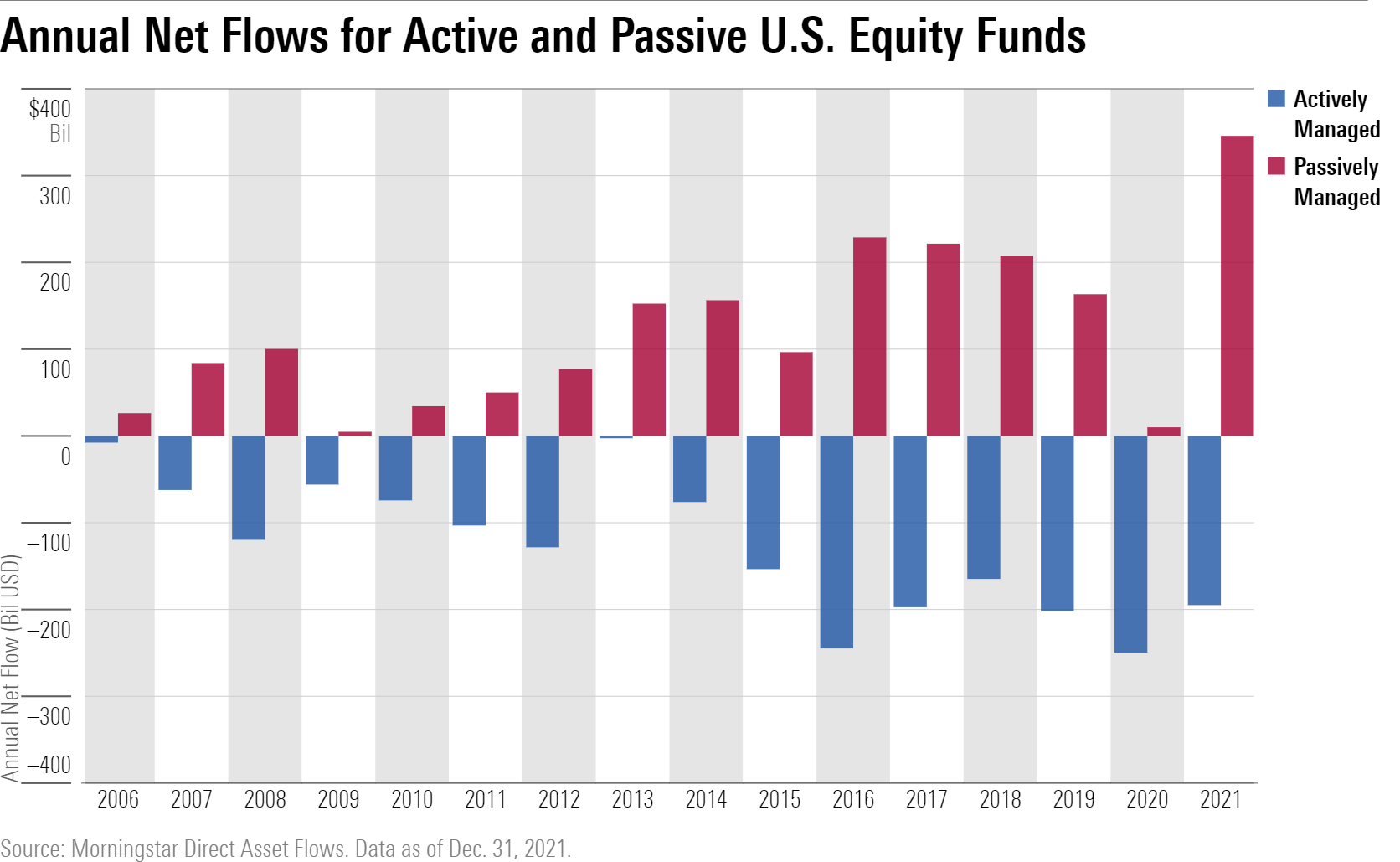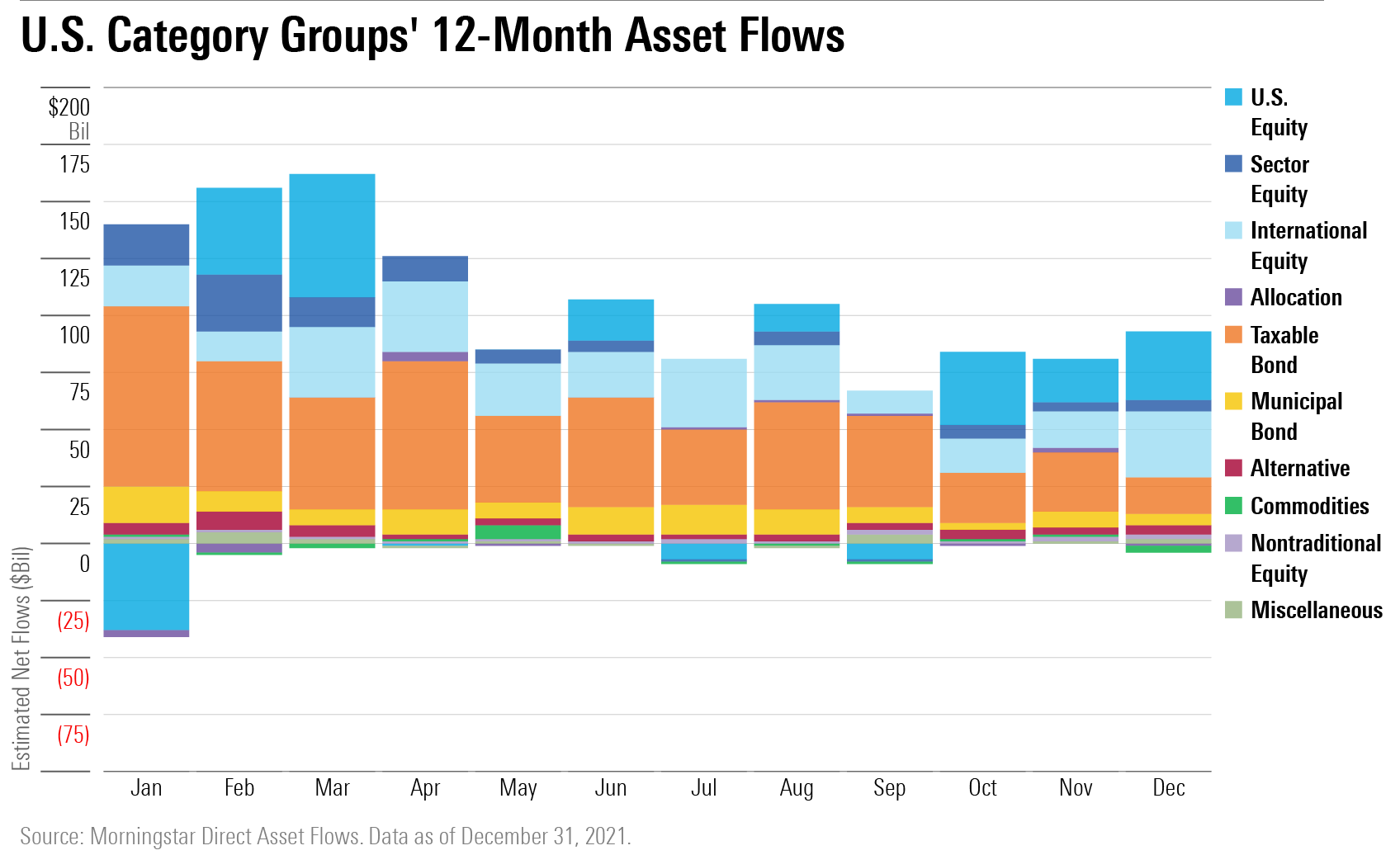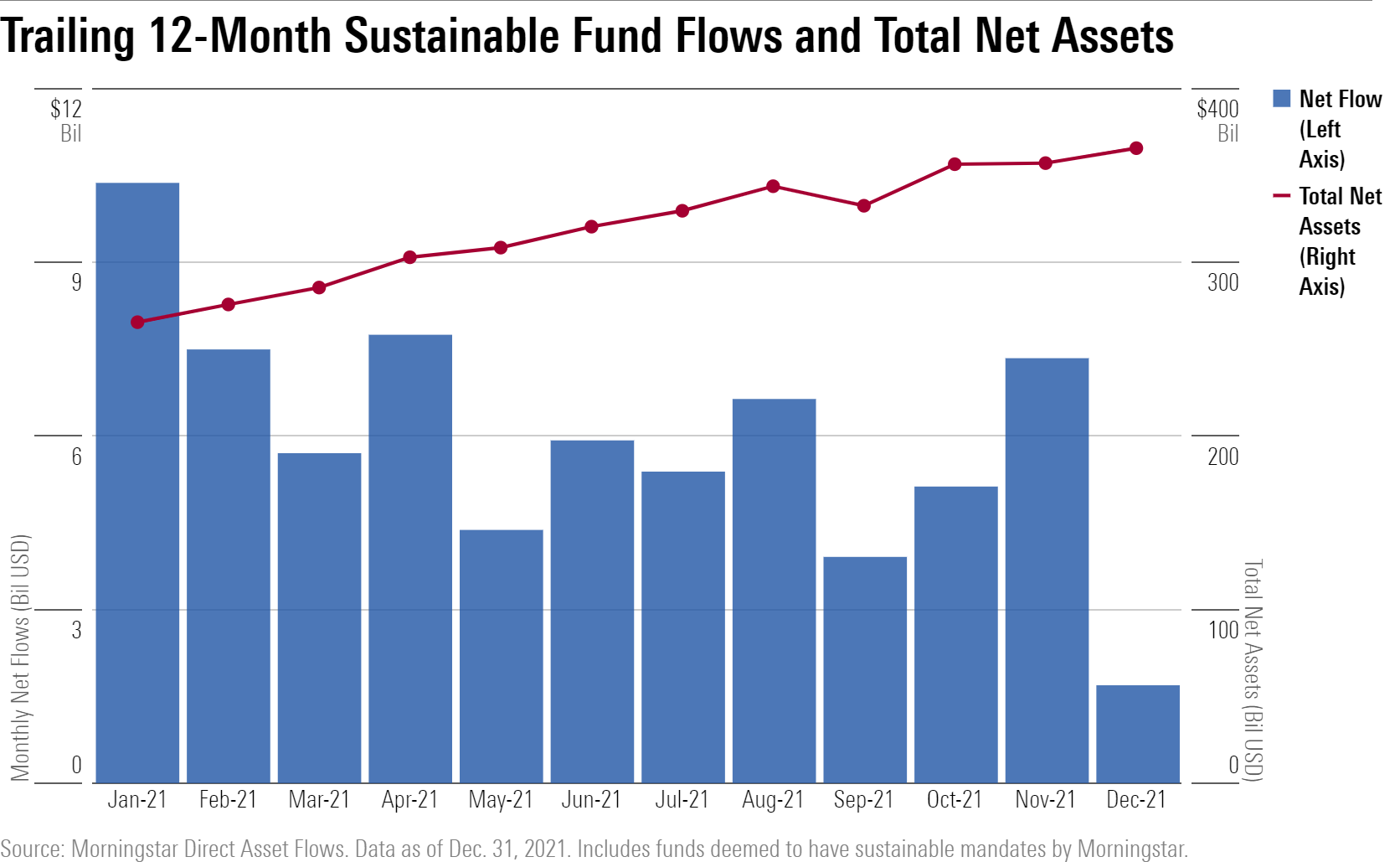U.S. Fund Flows Smashed Records in 2021
Investors embraced passive funds and tried to counter inflation.

Editor's note: This is adapted from the Morningstar Direct U.S. Asset Flows Commentary for December 2021. Download the full report here.
U.S. long-term mutual funds and exchange-traded funds gathered $88 billion in December, capping off a record year. Investors poured $1.2 trillion into these vehicles in 2021, nearly double the previous annual record of $689 billion set in 2017. About $730 billion of the $1.2 trillion entered markets during the first six months of the year, peaking at nearly $160 billion in March.

Passively managed funds collected roughly $96 billion in December, while active funds shed more than $8 billion, making the month a microcosm of the year. Passive funds raked in $958 billion in 2021, over $700 billion more than their active counterparts. The mere fact that active funds took in new money is an accomplishment as they suffered outflows in every year from 2015 to 2020.

The minor comeback for active funds was mainly due to strong flows into actively managed taxable-bond funds. Active shops in this segment have been putting up a fight against passive alternatives. They gathered $257 billion in 2021, just a bit below passive taxable-bond funds' $275 billion intake.
Despite taxable-bond funds' dominance in recent years, their share of the overall pie of investor assets has remained roughly the same. This is because equity markets have appreciated significantly, such that their piece has held steady or increased slightly despite substantially weaker flows. Strong taxable-bond flows may be partly reflective of rebalancing activity.

U.S. equity funds gathered $30 billion December, bringing their 2021 total intake to $151 billion. After shedding $240 billion in 2020 (their worst year ever on an absolute basis), investors once again embraced U.S. equity funds as markets soared and interest rates remained low. Large-blend funds took home $24 billion in December and $127 billion in 2021, the most of any Morningstar Category. Passive funds represented all U.S. equity inflows during the year. They collected $346 billion, while active funds shed $195 billion.

This year was clearly one for value funds. Large-value funds took in just $1.8 billion in December but collected a record $60 billion in 2021. Small-value funds also had a resurgence, collecting $7.5 billion in 2021, their most since 2004. Growth funds, by contrast, struggled mightily. Despite a rare inflow of $8 billion in December, large-growth funds bled $50 billion in 2021, the largest absolute outflow of any category. They've remarkably shed assets in 14 consecutive calendar years, though rebalancing activity may have played a role here as well given that market segment's stellar performance. Mid-growth funds suffered a $5.3 billion outflow in December, their most on record on an absolute basis.
Sector-equity funds ended 2021 quietly with just a $4.8 billion inflow in December, but their strength earlier in the year earned a record annual inflow of $98 billion. Financial funds led the way with a $24 billion inflow for the year, followed by real estate funds' $18 billion, natural-resources funds' $15 billion, and equity energy funds' $11.5 billion. International-equity funds collected $29 billion in December, cementing a stellar year that saw $262 billion of inflows, the most of any equity U.S. category group.
International-equity funds enjoyed inflows in every month in 2021 after just four such months in 2020. Foreign-large blend funds carried the category group in December and in 2021, taking in $19 billion and nearly $120 billion, respectively.
For the sixth consecutive year, taxable-bond funds led all U.S. category groups in annual inflows. They had collected over $531 billion when the book closed on 2021, more than double international equities' second-place sum.

Inflation-protected bond funds were the belle of the fixed-income ball in 2021. The $75.1 billion they absorbed shattered their previous annual record of $29.2 billion, set in 2009. These funds' year was both lucrative and consistent; investors poured between $5 billion and $10 billion into these funds in each month of 2021.
Bank-loan funds, which also offer ballast during rising interest-rate environments, rode widespread inflation worries to a stellar year as well. After adding $3.1 billion of new money in December, these funds closed the year with $45.7 billion in net flows, their healthiest haul since 2013. That translated into an organic growth rate of nearly 67%--the highest among all taxable-bond categories by a wide margin.
Municipal-bond funds had a solid year as well. After pulling in $4.9 billion of new money in December, they tallied over $106 billion in net flows on the year, narrowly eclipsing the previous record set in 2019. While that was a more modest haul than their taxable peers', it translated into an 11.3% organic growth rate that exceeded taxable-bond funds' 10.4%.
Funds focused on environmental, social, and governance objectives had a strong year in 2021. While they collected their lowest monthly total in December, their $71 billion intake for the year easily eclipsed 2020's $51 billion total. Sustainable funds enjoyed widespread success across equity, fixed-income, and alternative asset classes, though sustainable U.S. equity funds took home the most with $34 billion of inflows.

The list of the 10 largest U.S. fund families featured the same constituents at the end of 2021 as at the start. IShares' leap into third place over American Funds represents the only difference. The widespread shift from active to passive funds likely helped power iShares' ascension into the third-place seat. Another major beneficiary of the shift into index funds was Vanguard, the 2021 flows leader. The behemoth raked in $361.9 billion last year--over $150 billion more than iShares, its next-closest competitor ($204.6 billion). Over 93% of the new money that Vanguard collected last year streamed into its roster of index products.

Note: The figures in this report were compiled on Jan. 12, 2022, and reflect only the funds that had reported net assets by that date. Morningstar Direct clients can download the full report here.

/s3.amazonaws.com/arc-authors/morningstar/96a2625e-83c2-4fdb-9fd7-0efcd07c88bb.jpg)
/s3.amazonaws.com/arc-authors/morningstar/30e2fda6-bf21-4e54-9e50-831a2bcccd80.jpg)
/d10o6nnig0wrdw.cloudfront.net/04-25-2024/t_d30270f760794625a1e74b94c0d352af_name_file_960x540_1600_v4_.jpg)
/cloudfront-us-east-1.images.arcpublishing.com/morningstar/DOXM5RLEKJHX5B6OIEWSUMX6X4.png)
/cloudfront-us-east-1.images.arcpublishing.com/morningstar/ZKOY2ZAHLJVJJMCLXHIVFME56M.jpg)
:quality(80)/s3.amazonaws.com/arc-authors/morningstar/96a2625e-83c2-4fdb-9fd7-0efcd07c88bb.jpg)
:quality(80)/s3.amazonaws.com/arc-authors/morningstar/30e2fda6-bf21-4e54-9e50-831a2bcccd80.jpg)